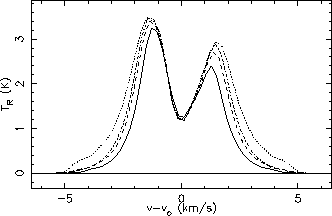 Variation of Line Profiles with viewing angle.
Variation of Line Profiles with viewing angle.
| solid | 45 |
| dashed | 30 |
| dot-dashed | 15 |
| dotted | 0 |
Clearly a cloud that is rotating only around its central axis will have no component of velocity in the vertical
direction. It might therefore at first be thought that when viewing the cloud from above, the line profile would revert to
the same shape as for a completely stationary cloud. However, inspection of
figures 6.2 & 6.3 shows this
not to be the case. The figures show exactly the same model as used previously (ie. with the same parameters as
given on page ![]() ). For the first 45
). For the first 45![]() of rotation only relatively small changes in the
line shape are visible, however, above 45
of rotation only relatively small changes in the
line shape are visible, however, above 45![]() the line shape rapidly becomes narrower and since the emission is
then less spread out in velocity it also becomes more intense. When viewing the cloud perpendicular to the plane of
rotation6.1 the line shape is indeed rather similar to the shape generated from a non-rotating cloud.
Line emission at 89.9
the line shape rapidly becomes narrower and since the emission is
then less spread out in velocity it also becomes more intense. When viewing the cloud perpendicular to the plane of
rotation6.1 the line shape is indeed rather similar to the shape generated from a non-rotating cloud.
Line emission at 89.9![]() for different rotation speeds
for different rotation speeds
| solid | 0 |
| dashed | 0.1
|
| dot-dashed | 0.2
|
![\includegraphics[scale=0.95]{buktilt3.eps}](img1158.gif) However, on closer inspection there are still small differences. These differences are more clearly visible in figure 6.4 where the solid line is the line profile
for a stationary cloud. The dashed line is the rotating version which can be seen to have slightly less
intense emission. The reason for this is that as the central core of the cloud is rotating its emission is
distributed over a larger velocity range. Therefore at any particular velocity the optical depth of the
central part of the cloud will appear to be less than for the equivalent non-rotating cloud. This enables
radiation from the centre of the cloud to leak out to the outer portions of the cloud, thereby cooling the
centre. If this explanation is correct then the effect ought to be stronger for faster rotating clouds. The
dot-dashed line in figure 6.4 has twice the rotation velocity of the dashed line and it can
be seen that the difference in intensity is indeed more pronounced.
However, on closer inspection there are still small differences. These differences are more clearly visible in figure 6.4 where the solid line is the line profile
for a stationary cloud. The dashed line is the rotating version which can be seen to have slightly less
intense emission. The reason for this is that as the central core of the cloud is rotating its emission is
distributed over a larger velocity range. Therefore at any particular velocity the optical depth of the
central part of the cloud will appear to be less than for the equivalent non-rotating cloud. This enables
radiation from the centre of the cloud to leak out to the outer portions of the cloud, thereby cooling the
centre. If this explanation is correct then the effect ought to be stronger for faster rotating clouds. The
dot-dashed line in figure 6.4 has twice the rotation velocity of the dashed line and it can
be seen that the difference in intensity is indeed more pronounced.